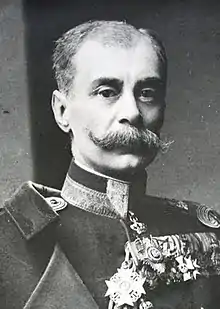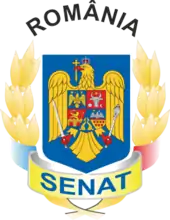Constantin Coandă
Constantin Coandă (4 March 1857 – 30 September 1932)[1][2] was a Romanian soldier and politician.
Constantin Coandă | |
|---|---|
 | |
| Prime Minister of Romania | |
| In office 24 October 1918 – 29 November 1918 | |
| Monarch | Ferdinand I of Romania |
| Preceded by | Alexandru Marghiloman |
| Succeeded by | Ion I. C. Brătianu |
| President of the Senate of Romania | |
| In office 22 June 1920 – 22 January 1922 | |
| Monarch | Ferdinand I of Romania |
| Preceded by | Paul Bujor |
| Succeeded by | Mihail Pherekyde |
| In office 18 July 1926 – 5 June 1927 | |
| Preceded by | Constantin I. Nicolaescu |
| Succeeded by | Constantin I. Nicolaescu |
| Personal details | |
| Born | 4 March 1857 Craiova, Wallachia |
| Died | 30 September 1932 (aged 75) Bucharest, Kingdom of Romania |
| Spouse(s) | Aïda Danet |
| Children | 7 children (among them Henri Coandă) |
| Military service | |
| Branch/service | Romanian Land Forces |
| Rank | General de corp de armată |
Biography
Constantin Coandă was born in Craiova. He reached the rank of general in the Romanian Army, and later became a mathematics professor at the National School of Bridges and Roads in Bucharest. Among his seven children was Henri Coandă, the discoverer of the Coandă effect.
During World War I, for a short time (24 October – 29 November 1918), he was the Prime Minister of Romania[3] and the Foreign Affairs Minister. He participated in the signing of the Treaty of Neuilly between the Allies of World War I and Bulgaria.
On 8 December 1920, during his term as President of the Senate of Romania (representing Alexandru Averescu's People's Party), he was badly wounded by a bomb set up by the terrorist and anarchist Max Goldstein.
Military functions
- Platoon commander in the 1st Artillery Regiment (1877 – 1883)
- Positions in military education at the Bucharest School of Artillery, Engineering and Naval Officers and at the Superior School of War
- Command and staff functions
- Commander of the 2nd Artillery Regiment
- Commander of the 5th Army Corps
- Secretary General of the Ministry of War
- Commander of the Bucharest Citadel
- Military attaché in Berlin, Vienna and Paris
- Director of the Artillery Department of the Ministry of War
- Head of department in the General Staff
- Inspector General of Artillery.
Other positions
- Teacher at the Bucharest Bridge and Roads School
- Delegate to the International Conference in The Hague
- Military and diplomatic attaché near the Quarter of Tsar Nicholas II (1916 – 1918)
- Minister of Industry (March 20 – July 14, 1926)
- Minister Secretary of State (August 10, 1926 – June 4, 1927) .
Writings
- Artillery Course (1884 – 1885)
- Projectiles and Missiles (1884).
Death
Constantin Coandă died on 30 September 1932, aged 75, in Bucharest.
References
- Schimbam, Uniti (29 November 2018). "Evenimentele Zilei de 29 noiembrie în Istorie". Retrieved 16 May 2019.
- Nicolae Titulescu (1994). Romania's foreign policy: 1937. Encyclopaedic Publishing House. p. 305. ISBN 978-973-45-0092-5.
- Kurt W. Treptow; Centrul de Studii Românești̦ (1999). Romania During the World War I Era. Center for Romanian Studies.

